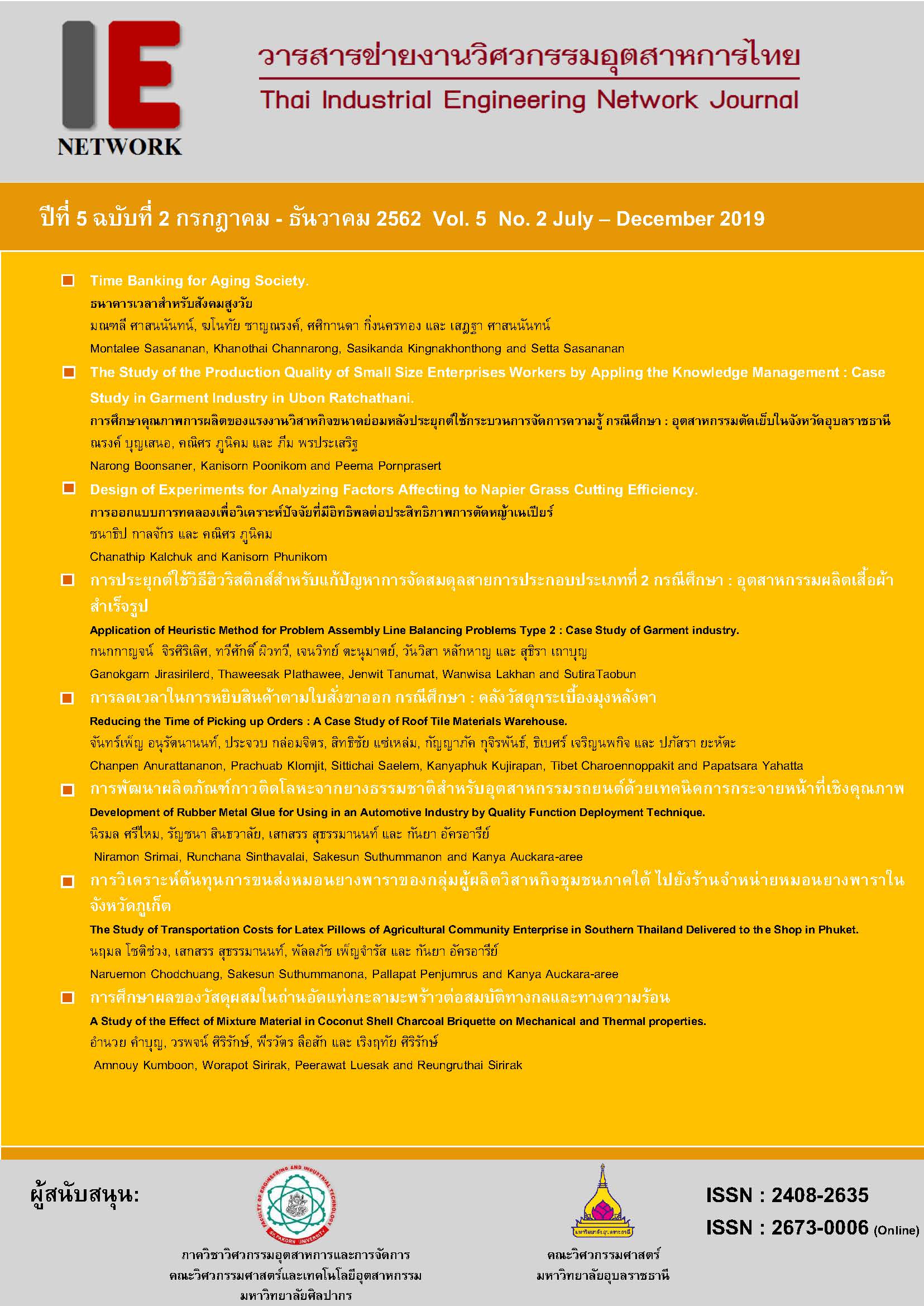Development of Rubber Metal Glue for Using in an Automotive Industry by Quality Function Deployment Technique
Main Article Content
Abstract
The objective of this research was to propose the value improvement (VI) for Mastic adhesive (MA) product made from synthetic rubber (SR)—Nitrile Butadiene Rubber (NBR) turning to use Natural Rubber instead. Quality Function Deployment (QFD) is the technique of studying the need of users and transforming to design and technical specifications of the product. The research starts from identifying the glue characteristic from users and technical requirements from producers. Both requirements are analyzed to evaluate the possibility of rubber glue production using Quality Function Deployment (QFD) technique. The result shows that five most important technical requirements are Tensile Strength (18.77%), Viscosity (18.58%), Adhesive Strength (13.85%), Hardness (10.46%) and Modulus (9.70%), respectively. Subsequently, those technical requirements were considered to the characteristics of natural rubber. It can be concluded that metal adhesive made from natural rubber can be used as a substitute for synthetic rubber, The result of the value improvement arising from natural rubber metal glue is expected to meet the need of users based on the above requirements. This would also cause better flow of economy and trade for the rubber industry within the country.
Article Details
บทความ ข้อมูล เนื้อหา รูปภาพ ฯลฯ ที่ได้รับการตีพิมพ์ในวารสารฯ ถือเป็นลิขสิทธิ์ของวารสารฯ หากบุคคลหรือหน่วยงานใดต้องการนำทั้งหมดหรือส่วนหนึ่งส่วนใดไปเผยแพร่ต่อหรือเพื่อกระทำการใดๆ จะได้รับอนุญาต แต่ห้ามนำไปใช้เพื่่อประโยชน์ทางธุรกิจ และห้ามดัดแปลง
References
[2] บริษัท ซีลิค คอร์พ จำกัด (มหาชน). วิเคราะห์ตลาดกาวโลก. [ออนไลน์]. 2558. [เข้าถึงเมื่อ 23 พฤษภาคม 2561]. เข้าถึงได้จาก: https://capital.sec.or.th/
[3] วิบุญ ตั้งวโรดมนุกูล. วัสดุขั้นสูง (Advanced materials) ในอุตสาหกรรมยานยนต์. [ออนไลน์]. 2559. [เข้าถึงเมื่อ 23 พฤษภาคม 2561]. เข้าถึงได้จาก: https://www.applicadthai.com/articles/
[4] บริษัท ซันสตาร์ เคมิคัล (ประเทศไทย). ประเภทของกาวติดภายในรถยนต์. พนักงานฝ่ายวิจัยและพัฒนา [ออนไลน์]. 2560. [เข้าถึงเมื่อ 28 พฤษภาคม 2561]. เข้าถึงได้จาก: https://th.sunstar-chemical.com/
[5] Maguad, Ben A. Using QFD to Integrate the Voice of Customer into the Academic Planning Process [Online]. 2009 [Access 21 May2018]. Retrieved from: https://www.researchgate.net/publication/268272118
[6] ศิริชัย ยศวังใจ. กระบวนการออกแบบและพัฒนาผลิตภัณฑ์. วารสารวิชาการวิศวกรรมศาสตร์ ม.อบ. 2558. ปีที่ 8; เล่มที่ 1.
[7] Cohen, Lou. Quality Function Deployment Matrix. Quality Function Deployment: How to Make QFD Work for You. India. 2005.
[8] ชิณดิษฐ์ ทุมชาลี. การประยุกต์ใช้เทคนิควิศวกรรมคุณค่าสำหรับการออกแบบสวิตชิ่งพาวเวอร์ซัพพลาย กรณีศึกษา อุสาหกรรมผลิตอุปกรณ์อิเล็กทรอนิกส์. วารสารสถาบันเทคโนโลยีไทย-ญี่ปุ่น: บริหารธุรกิจและภาษา. 2555. ปีที่ 1; เล่มที่ 1.
[9] เจริญ นาคะสรรค์ และคณะ. การเตรียมกาวยางจากการกราฟต์โคพอลิเมอร์ของยางธรรมชาติกับเมทิลเมทาคริเลท. ภาควิชาเทคโนโลยียางและพอลิเมอร์ คณะวิทยาศาสตร์และเทคโนโลยี มหาวิทยาลัยสงขลานครินทร์ วิทยาเขตปัตตานี. 2551.
[10] เจริญ นาคะสรรค์ และคณะ. การผลิตกาวติดไม้และกาวติดโลหะจากน้ำยางธรรมชาติดัดแปลงโมเลกุล. สำนักงานกองทุนสนับสนุนการวิจัย. 2558.
[11] วิศรุต คงสกุล. การออกแบบและพัฒนาอุปกรณ์จับยึดสำหรับการสอบเทียบไขควงวัดแรงบิดตามมาตรฐาน ISO 6789: 2003 (E) ด้วยเทคนิคการกระจายหน้าที่เชิงคุณภาพ. วารสารข่ายงานวิศวกรรมอุตสาหการไทย. 2561. ปีที่ 4; เล่มที่ 1.


